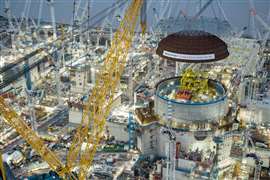Order books up at Terex but crane sales cool
26 July 2010
Net sales at Terex Cranes dropped US$23.8 million, or 5%, to $449.1 million in the second quarter of 2010, compared to the same quarter in 2009.
Excluding the translation effect of foreign currency exchange rate changes and acquisitions, net sales decreased about 21% against the second quarter of 2009.
Lower capacity crane demand, including the lower end of the all terrain line, continued to weaken in the second quarter of 2010 compared to the same 2009 quarter as commercial construction demand remained soft, said the company.
Customers continued to purchase high capacity crawler cranes during the quarter, driven by global infrastructure and power projects. Tower crane and rough terrain crane demand remained stable, albeit at low levels, Terex added, while other smaller product lines, including the Australian pick-and-carry crane and the Chinese truck crane businesses, showed improved demand in 2010.
Tom Riordan, Terex president and chief operating officer, commented, "Overall, order activity in most of our product categories increased during the second quarter of 2010 compared with the previous quarter and previous year period. However, as expected, our cranes segment continued to experience a net sales and backlog decline versus the prior year period.
"We expect this trend to continue, but moderate during the balance of 2010. A bright spot within the cranes segment was the improvement in the Terex Port Equipment business. Order inquiries for this business have increased substantially compared to last year and we are seeing the positive impact of restructuring programs take effect."
Operating profit in the cranes segment during the second quarter of 2010 was $17 million, a decrease of $8 million when compared with an operating profit of $25 million during the comparable period 2009. Operating margin decreased to 3.8%, compared to 5.3% in the second quarter of 2009.
Lower net sales, partially offset by the mix of larger cranes in the production schedule and the impact of reduced materials cost, reduced profits by about $13 million. Enhanced factory utilization improved operating results by about $8 million when compared with the second quarter of 2009, added the company.
Overall, Terex Corporation, announced a net loss from continuing operations for the second quarter of $13.1 million, or $0.12 per share, compared to a net of $99.6 million, or $1 per share, for the same period in 2009.
Net sales for continuing operations were $1.080 billion in the second quarter, an increase of 14% from $947.3 million in the same period 2009. Excluding the impact of acquisitions, net sales increased about 6% from the comparable prior year period.
"We have just completed a challenging first half of 2010, but many of our businesses have seen their recent results show improvement of trough levels experienced during 2009," commented Ron DeFeo, Terex chairman and chief executive officer.
"We are cautious, but positive, about our prospects for continued improvement. Backlog in three of our four segments indicate slightly improved near-term prospects. Our factories have returned to more regular work schedules and production output. These improving business conditions are the basis for our cautious optimism about the balance of 2010 and lay the foundation for what we feel will be a positive business environment in 2011 for most of our product categories," DeFeo added.
Cranes segment backlog decreased about 37% compared to June 30, 2009, and decreased about 18% compared to March 31, 2010. The latter decrease amounts to about 12% after adjusting for the translation effect of foreign currency exchange rate changes. Excluding the impact of acquisitions, backlog decreased about 51% compared to June 30, 2009 levels.






